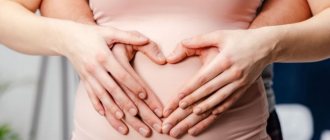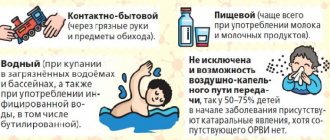Pregnant women experience a variety of pain sensations, and it is sometimes difficult to know which pain is normal and which is a symptom of a serious illness. Very often, pregnant women experience pain in the right side of the lower abdomen. When a woman feels such pain, she should first consult a doctor to understand the cause. For almost all reasons, it is necessary to call an ambulance or see a doctor.
The nature of pain during different periods of pregnancy
Gestation is divided into three three-month stages - trimesters.
Since the condition of pregnant women has been studied comprehensively, there is objective data about their well-being from conception to childbirth. First trimester. Pain in the lower abdomen can occur in the very early stages of pregnancy. They are caused by the process of attachment of the embryo to the wall of the uterus. Such pain is considered normal if it is not caused by something else.
Usually the pressure or tingling caused by implantation is not pronounced and does not last long. This could be a tingling sensation, a slight burning sensation, or sensitivity at the level of “something is happening there.” If the pain does not stop for a long time and makes you want to take painkillers, then you should definitely consult a doctor to find out the reasons for such deviations. Otherwise, the situation may threaten the fetus.
At different stages of the first trimester, pregnant women experience pain that radiates to the lower back. They are typically caused by a shift in the center of gravity and mild spasms of the muscles that stabilize the spine. Previously unloaded fibers of these muscles begin to work, but quickly get tired, causing similar sensations. Over time, they train, become stronger and stop spasming. But lumbar pain is sometimes associated with pathology of the urinary system. As a rule, this is the development of infectious diseases, accompanied by accompanying symptoms: difficulty urinating, fever, burning in the urethra.
The most alarming signal that threatens the fetus is uterine bleeding. At the first bleeding, you should immediately consult a doctor.
Second trimester. Towards the middle of the gestation period, the uterus enlarges so much that the round ligament that supports it begins to experience tension, which causes pain. These attacks last a few minutes but can occur several times a day. The absence of such sensations is not a deviation at this stage.
After about the 20th week of pregnancy, some women o. This is due to uterine hypertonicity, which is controlled with medication.
By the end of the second trimester, the lumbar spine curves forward even more due to a shift in the center of gravity. As a result, a pregnant woman, especially while walking, may experience spasms, as with radiculitis. Avoiding this will help avoid wearing high-heeled shoes and do exercises designed for pregnant women.
Third trimester. Entering the final stage of bearing a child, the female body undergoes a lot of changes. From the 35th (sometimes earlier) week, women begin to experience training contractions, which cause a feeling of heaviness in the lower abdomen. A woman quickly gets used to such sensations, but if they become frequent and severe, it is recommended to consult a doctor, because this may be a sign of preterm labor contractions.
Towards the end of pregnancy, the baby's head begins to put pressure on the pelvic bones, which leads to increased tension in the lower abdomen and spasms of regional muscles. Normally, such pain is tolerable. But if they become excessive, you should immediately consult a doctor.
Appendicitis
Appendicitis also often makes itself felt during pregnancy. The malaise is accompanied by elevated body temperature, chills, nausea, sometimes vomiting and acute attacks of pain that last for a long time. Moreover, initially the pain syndrome appears in the epigastric region, and then passes to the inguinal-iliac area.
The expectant mother urgently needs to call an ambulance - otherwise, serious health complications are possible due to an inflamed appendix. The appendix can only be removed surgically.
Food poisoning
Any woman is familiar with the sensations that arise from food poisoning. It could be:
- severe nausea;
- excessive salivation;
- vomit;
- diarrhea;
- temperature increase;
- spasms in the intestinal area.
Poisoning can be chemical or infectious. A pregnant woman can survive mild food poisoning without consequences, but more severe conditions, especially with an increase in temperature, require immediate medical attention. In this case, you cannot self-medicate, since there are a number of nuances and restrictions (including medications) for pregnant women.
In what cases is it necessary to immediately contact a gynecologist?
- A sharp sharp pain appeared in the abdominal area.
- It does not stop hurting after 30 minutes, there is a feeling that the pain is getting stronger and stronger.
- Unpleasant stretching and pain for 2 days.
- Pain in the right side combined with dangerous symptoms: fever, chills, nausea, vomiting, increased sweating, rash, etc.
Remember that without medical education, you and your relatives can only make a conditional diagnosis on your own. It is important to know the causes and symptoms in order not to stay at home in case of real danger, and not for self-medication.
Pain during ectopic pregnancy and threatened miscarriage
The occurrence of an ectopic pregnancy cannot be judged only by symptoms, which include pain in the lower abdomen and bleeding. But these are clear signals for an urgent visit to a doctor, who will perform an ultrasound and determine their true cause. Most often, ectopic pregnancy is localized in the tubes. As the embryo develops and stretches the walls of the fallopian tube, pain occurs. They become more frequent and intensified, unlike obstetric pain.
If there is a threat of miscarriage, which can happen at any stage of pregnancy, the pain is localized in the center of the lower abdomen and is accompanied by contractions. Intuitively, many women, especially those with childbirth experience, can distinguish training contractions and obstetric pain from pathological ones. But if a pregnant woman notices unnatural pain in her abdomen (especially in the center), then it is better for her to play it safe by contacting a doctor, at least by phone to describe her condition. The threat of miscarriage also arises when uterine bleeding occurs, which is also accompanied by a sharp loss of strength.
Preventive actions
The following tips will help reduce the likelihood of developing colic during pregnancy:
- Follow doctor's recommendations
- Watch your diet
- Visit a gynecologist regularly
- Have a good rest
- Competently treat diseases of the urinary and digestive systems
During pregnancy, it is better to be safe than to bite your elbows later. If unpleasant symptoms occur, immediately consult a doctor and undergo a course of treatment.
Tension of muscles and ligaments
Developing in the uterine cavity, the fetus enlarges and stretches its walls. This process is accompanied by stretching of the ligaments that stabilize the position of the uterus. Both the uterus and its ligaments are adapted to such stretching, but pregnant women may experience discomfort, even pain, against this background. In order not to confuse such pains with pathological ones, you need to pay attention to their frequency and duration. The pain is accompanied by micro-tears of the connective tissue of the ligaments, which normally last no more than five minutes. If the pain does not go away longer, then this is a reason to doubt that it is caused by a sprain.
In late pregnancy, the muscles surrounding the peritoneum (oblique and rectus abdominis) also experience tension. There may be tingling pain when changing posture. They pass as quickly as they arise.
Baby
The body length of the baby at this stage is 28 cm, and the weight is about 340 g. Before this week of pregnancy, the length of the fetus was measured by calculating its length from the crown to the tailbone. After the 20th week, the specialist includes in the concept of growth the length of not only the body, but also the lower limbs.
At this stage of development, the child is quite active, makes numerous movements, since there is enough space in the uterus for him to somersault, push off from the walls, as well as other movements. The baby may smile, grasp the umbilical cord, touch himself, frown, and close his eyes. His facial expressions are quite developed and more pronounced than before.
The skin becomes dense, actively covered with vellus hairs and special lubricant. A large amount of this lubricant is found in the folds. This lubricant prevents the risk of mechanical friction, has bactericidal properties, and ensures optimal passage of the fetus through the mother's birth canal during childbirth.
It is impossible not to note the intensive development of the gastrointestinal tract. Small portions of amniotic fluid, which the child swallows, wash the walls of the intestines and stomach, lead to peristalsis training, and promote intestinal contraction.
At the 20th week, amniotic fluid is processed. The first stool formed in the child’s body is meconium. It has a dark green color. It consists of mucus, water, epithelial cells, and bile. Meconium accumulates in the intestinal lumen. On the first day of birth, it comes out.
Pain due to diseases of internal organs
Pregnant women are not immune from cholecystitis, appendicitis, exacerbation of kidney disease and internal genital organs. Often when these diseases occur, they associate pain symptoms primarily with position. But the symptoms of acute manifestations of these diseases are very different from normal obstetric pain. With appendicitis, abdominal pain increases, does not go away on its own, and is accompanied by fever, which forces you to immediately seek medical help.
With cholecystitis (inflammation of the gallbladder), which, by the way, occurs in women much more often than in men, girdle pain in the upper abdomen is characteristic. Often the pain radiates under the right shoulder blade; upon palpation, the area of projection of the gallbladder does not change. Attacks of cholecystitis occur mainly closer to midnight. They cannot be tolerated, because if left untreated, the gallbladder may rupture, which poses a serious threat to both the woman and the fetus. Acute cholecystitis in non-life-threatening stages can be preserved with medication and diet. In this case, surgery to remove the bladder with stones is carried out after childbirth.
Hiatal hernia is most often observed among women over 30 years of age who have already given birth. This is a hernia of the hole in the diaphragm through which the esophagus passes. The condition is complicated by the pressure of the enlarging uterus. Women with this pathology complain of pain in the chest, burning in the esophagus, belching and reflux of gastric juice into the esophagus. Treatment of pregnant patients has no special features. They are recommended to sleep on beds with a raised headboard, eat small meals with a reduced content of crude fiber, and take medications that relax the intestines.
Fetal movement. From about the eighth week, the baby begins to move in the womb, and the expectant mother naturally feels this. The date of the first spontaneous movements of the fetus and the location of the tremors must be reported to the doctor. This information is important for determining the position of the fetus and even helps determine the due date.
Training (false) contractions. Short-term cramping uterine contractions feel very similar to real labor contractions. They are accompanied by not very severe pain, and the stomach itself becomes “stone-like.” The frequency of false contractions, unlike labor contractions, is decreasing. During training contractions, the cervix does not dilate, so they do not threaten the fetus. But for the woman herself, they cause discomfort and anxiety.
Abdominal organs of the right hypochondrium, lateral and iliac regions
The human torso is conventionally divided into two parts: the chest and abdomen. The belly is divided into nine parts.
The abdomen is conventionally divided into 9 regions
Abdominal organs on the right:
- in the subcostal region:
- the right lobe of the liver and partially its left lobe;
- the upper part of the right kidney with the adrenal gland;
gallbladder with excretory ducts for bile;
- ascending colon;
- ileum and cecum with appendix;
- transition of the stomach to the duodenum;










